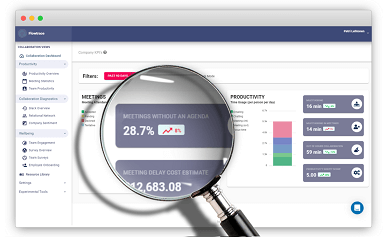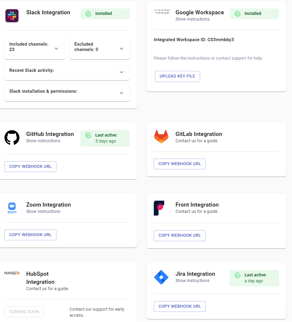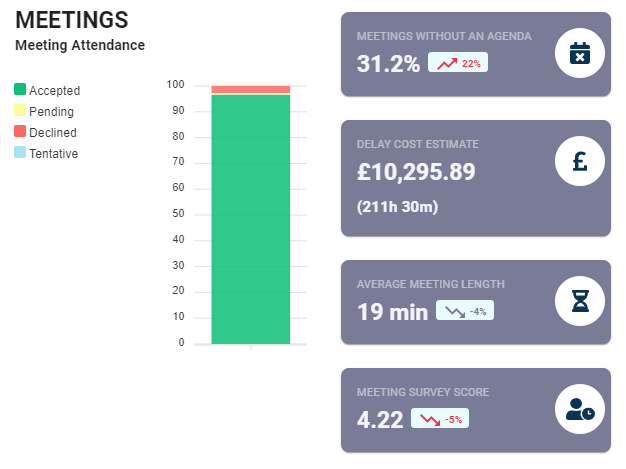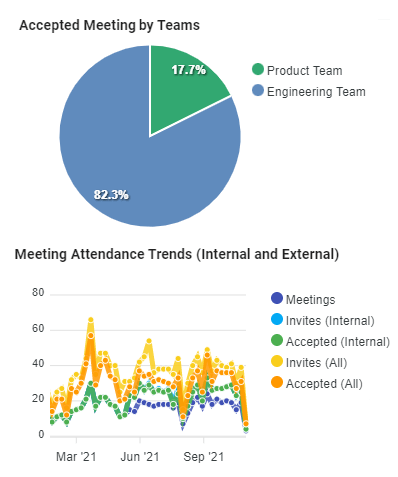In today's fast-paced, tech-centric business landscape, effective meetings are crucial for driving productivity and collaboration. However, many organizations struggle with meeting overload, poor decision-making, and inefficient use of time. Flowtrace's Company Analytics platform provides a solution to these challenges by leveraging meeting analytics to transform the way your teams collaborate and communicate. In this article, we'll explore the role of meeting analytics in the modern workplace, discuss how to address common pain points, and delve into the benefits of implementing meeting analytics using Flowtrace's innovative platform. The benefits are not confined to your meeting culture.
The Role of Meeting Analytics in the Modern Workplace
Meeting analytics is the process of collecting, analyzing, and interpreting data related to meetings to optimize their effectiveness and efficiency. By examining key metrics such as meeting duration, attendance, punctuality, and participant engagement, businesses can identify patterns and trends that may impact overall performance.

Implementing meeting analytics can provide valuable insights into how teams collaborate, communicate, and make decisions. These insights allow organizations to make data-driven improvements to their meeting culture, ultimately leading to better business outcomes.

Common Meeting Pain Points
Here we list the most common meeting pain points, symptoms, and how to tackle them with meeting analytics.

Meeting overload and wasted time
By analyzing data on meeting frequency, duration, and attendance, businesses can identify instances of meeting overload and take corrective action. Flowtrace's platform helps organizations streamline their meeting schedules and prioritize essential meetings to reduce overload and improve productivity.
Poor decisions and agenda-less meetings
Meeting analytics can highlight meetings with unclear objectives or a lack of structure. Flowtrace's platform encourages the use of clear agendas and objectives, fostering more focused and effective meetings.
Punctuality and meeting attendance
Tracking punctuality and attendance metrics can reveal patterns of late arrivals or absenteeism. Flowtrace's platform supports initiatives to improve punctuality and attendance, such as scheduling adjustments or gentle reminders.
Anonymous meeting feedback and ratings
Gathering anonymous feedback and ratings from meeting participants can provide insights into meeting effectiveness and areas for improvement. Flowtrace's platform makes it easy for employees to provide feedback, helping meeting organizers continuously refine their meeting practices.
The Benefits of Meeting Analytics
Here's a list of most impactful benefits you and your team will experience by introducting systematic meeting analytics.

Improved collaboration and communication
Meeting analytics can help identify communication breakdowns, enabling businesses to address issues and foster more effective collaboration.
Streamlined decision-making
With data-driven insights into meeting effectiveness, organizations can optimize their decision-making processes, leading to better outcomes and faster progress.
Enhanced employee engagement and satisfaction
By reducing meeting overload and improving the quality of meetings, businesses can boost employee satisfaction and engagement.
More efficient use of time and resources
Meeting analytics enables organizations to make better use of their time and resources, increasing overall efficiency and productivity.
Harnessing the Power of Flowtrace's Meeting Analytics
Integration with Common Workplace Apps and Tools
 Flowtrace's platform is designed to seamlessly integrate with popular workplace tools, including Slack, Google Workspace, Google Meets, Zoom, Google Calendar, Google Docs, Jira, ClickUp, Asana, GitHub, Gitlab, HubSpot, Pipedrive, Front, and Intercom. This wide range of integrations enables businesses to collect and analyze meeting data from multiple sources, ensuring comprehensive insights.
Flowtrace's platform is designed to seamlessly integrate with popular workplace tools, including Slack, Google Workspace, Google Meets, Zoom, Google Calendar, Google Docs, Jira, ClickUp, Asana, GitHub, Gitlab, HubSpot, Pipedrive, Front, and Intercom. This wide range of integrations enables businesses to collect and analyze meeting data from multiple sources, ensuring comprehensive insights.
AI-Powered Recommendations and Benchmarking
Flowtrace's advanced AI algorithms analyze meeting data and provide recommendations on how to optimize meeting practices. These recommendations are benchmarked against data from similar organizations, ensuring contextually relevant insights. By comparing meeting performance against industry standards, businesses can better understand where they excel and where improvements are needed.

Customizable Dashboards and Reporting
Flowtrace's platform offers customizable dashboards that allow organizations to visualize meeting data and track key performance indicators (KPIs) over time. Users can create reports tailored to their specific needs, making it easy to monitor progress and identify trends. We provide all the filters to drill down to any part of your orgnaization.

Employee and Leadership Apps:
Employee App: Flowtrace's employee app includes personalized metrics and workday insights to help individuals understand their meeting habits and improve their productivity. The app also features weekly eNPS and team effectiveness surveys, company and channel reporting capabilities, meeting habit insights, and a knowledge base of articles to help employees refine their work practices.
Leadership App: The leadership app provides a comprehensive view of the organization's meeting performance, including AI recommendations benchmarked against industry standards, pulse survey results with up to 90% response rates, and data on communication, collaboration, and engagement metrics. This 360-degree view allows leadership teams to prioritize areas for improvement and make data-driven decisions.
Implementing Meeting Analytics with Flowtrace: A Step-by-Step Guide
Evaluate Your Current Meeting Culture: Begin by conducting an internal assessment of your existing meeting practices. Identify recurring issues, areas for improvement, and any existing data that can be leveraged for meeting analytics.
Introduce Flowtrace's Platform: Present the platform to your leadership team, highlighting its features, benefits, and potential impact on the organization. Provide resources and KPIs to ensure a smooth transition and adoption.

Collect and Analyze Meeting Data: Once Flowtrace's platform is integrated with your workplace tools, begin collecting meeting data. Analyze this data to identify trends, patterns, and areas for improvement.

Implement AI Recommendations: Utilize Flowtrace's AI-powered recommendations to address identified issues and optimize your meeting practices. Continuously monitor the impact of these changes and adjust as needed. You can choose to tackle the meeting culture also by your own.
Foster a Data-Driven Meeting Culture: Encourage employees and leadership to regularly review their meeting performance using the Flowtrace platform. Promote a culture of continuous improvement and data-driven decision-making.
Monitor Progress and Iterate: Continuously track your organization's meeting performance using Flowtrace's customizable dashboards and reporting. Identify areas where additional improvements can be made and iterate on your strategies to drive ongoing progress. Present core meeting metrics into your management meeting for the best results.
Meeting Analytics Parting Thoughts
In today's tech-driven business environment, mastering meeting analytics is essential for organizations looking to optimize efficiency and collaboration. By leveraging the power of Flowtrace's Company Analytics platform, businesses can gain insights into their meeting habits, address common pain points, and make data-driven improvements for better overall performance. Don't let outdated meeting practices hold your organization
